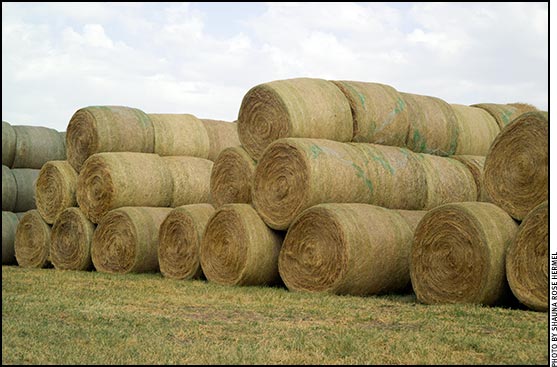Critical 60 Days
Hay quality fed to heifer affects calving success for next two years.
The quality of hay fed to a beef heifer the next 60 days of winter will determine the vigor of her calf to be born next spring, and whether she can rebreed to calve the next year.
The amount of fat on a heifer’s back determines the care she needs, says Justin Sexten, University of Missouri (MU) Extension beef nutritionist. His concern includes condition of cows in a herd, but heifers pregnant with first calves need extra nutrition.
Sexten is concerned about the coming calf crop — for the next two years — because of drought last summer. Too many beef females are going into winter without protective layers of fat that help carry them through until spring grass.
For some, hay supplies are limited and hay quality is low. A ration rich in nutrients allows cows to maintain body condition, keep the fat layer and develop a calf. Normally, hay does that.
“Unfortunately, much forage harvested last season does not meet base requirements,” Sexten says. Grain supplement will be needed if hay is not of adequate quality.
Herd owners judge the amount and what kind of feed will be needed from body condition scores (BCS) of cows.
By rule of thumb, a heifer should calve at 85% of her mature body weight. Most herds target 1,300-pound (lb.) mature cows. That mature weight is based on 5- to 8-year-old cow at BCS 5 on a scale of 1 to 9. That translates to a goal of 1,200 lb. at calving for heifers — 1,100 lb. of body mass plus 100 lb. of condition (see www.cowbcs.info).
Growing heifers need more and better feed than mature cows. They should be fed separately from the cows, Sexten says.
Body condition scores are measured in 100-lb. increments. Scoring estimates fat on the cow’s body. If she is flat across the back with no backbone or ribs showing, she scores BCS 6 or better, a desired condition for calving.
However, if her backbone “splits a raindrop,” she needs feed to add body fat before calving, Sexten says.
With normal summer and fall grass growth, heifers are grass-fat by winter. Not this year. “During July and August, when no grass grew, heifers mined condition off their back,” Sexten says.
Now heifers must be fed to support normal body and calf growth during winter, and also to replace lost fat.
Lost fat concerns Sexten. That energy source affects vigor of the calf at birth. Also, adequate body fat adds quality and quantity to milk the heifer provides her newborn calf.
Nutrition in that first 24 hours determines if a calf thrives, Sexten says. Spring-born calves come into a cold world. They need the rich energy and antibodies provided by colostrum, the first milk, to survive.
Adding one point to body condition score requires adding 100 lb. of fat to the mother’s body. That requires adding a pound of gain a day for the next 90 days for a March 1 calving.
If a herd is bred to calve Feb. 1, urgency increases.
In normal years, average hay maintains an average beef cow. The hay has protein and energy to maintain body condition and grow a calf.
A gestating cow needs hay with 10% protein. A lactating cow nursing a calf requires 12% protein.
“The only way to know hay’s nutrient content is with a forage test,” Sexten says. “Marginal hay requires supplementation.”
For many, that supplement means almost 4 lb. of corn-gluten feed on top of the hay. Often, that means buying a grain supplement. “You can pay now, or you pay later,” Sexten says. The choice comes down to buying feed now or risk the cow not rebreeding.
Sexten urges herd owners to consider risks of not feeding. If a heifer loses her calf, a $2,000 replacement heifer becomes worth $900 in salvage value.
A heifer in poor body condition after calving likely will not rebreed to calve the second year. That happens often, causing huge losses for beef herd owners. A lost heifer must be replaced.
Loss of a calf or heifer puts hay and grain prices in new perspective.
For more information on body condition scoring, visit www.cowbcs.info/.
Editor’s Note: This article was a press release by the University of Missouri College of Agriculture, Food and Natural Resources.
[Click here to go to the top of the page.]













